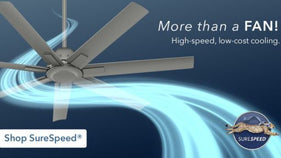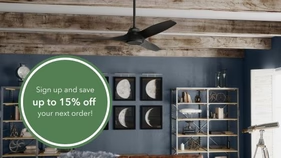- Home
- How to Choose a Ceiling Fan Size & Style | Hunter Fan
- How to Choose a Ceiling Fan Size & Style | Hunter Fan

How to choose a ceiling fan
In addition to cooling your space, a Hunter ceiling fan adds that decorative touch that ties the room together. Hunter designs a variety of ceiling fan styles with whisper-quiet motors and high-performance features to ensure maximum airflow. With so many ceiling fan sizes and styles to choose from, you may be wondering how to choose a ceiling fan for your space.
Whether you're upgrading a fan in a single room, renovating your entire home, or installing a new fan into a commercial property, this ceiling fan buying guide can help you pick a ceiling fan with confidence.
Table of Contents
- 1. Decide on a location for your fan
- 2. Choose the right ceiling fan size
- 3. Pick a ceiling fan style
- 4. Choose whether you want a fan with or without lights
- 5. Pick which mount-type works best for your space
- 6. Decide how you want to control your fan
- 7. Pick the airflow/efficiency you need
- 8. Set your budget

Step 1.
Where will you install your ceiling fan?

Residence or Business
When choosing a ceiling fan size and design for your space, location matters.
Residential Ceiling Fans
Hunter creates residential ceiling fan styles to go with every lifestyle. Innovative features and a variety of styles ranging from traditional to modern are ready to instantly upgrade the look of your home.
Industrial Ceiling Fans
Our industrial ceiling fans are designed to increase airflow while reducing energy consumption. These high-volume, low-speed (HVLS) fans are incredibly lightweight and circulate air more than any other type of traditional ceiling fan on the market. Hunter industrial fans provide super-quiet performance and our impressive fan warranties are among the best in the industry.
How to choose an indoor/outdoor ceiling fan
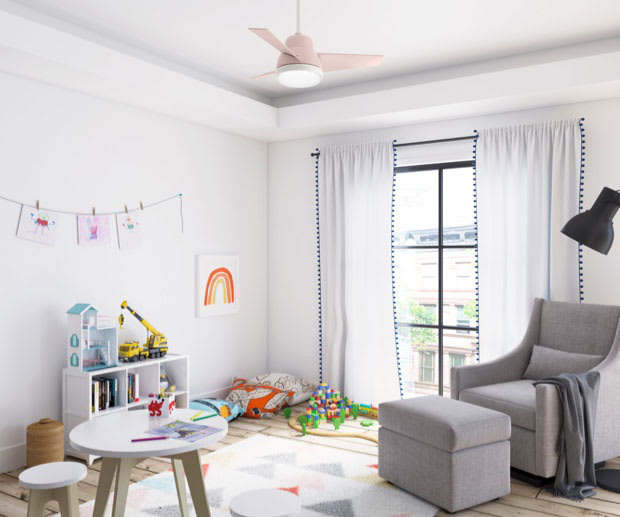
Indoors
When temperatures rise in the summer, a ceiling fan can keep your home feeling cool. During chilly weather, a ceiling fan can distribute heat throughout your home, too. While some outdoor fans can be used indoors, indoor fans cannot be used outdoors.
An indoor fan, which is sometimes referred to as a dry-rated, fan makes an ideal fit for a living room or bedroom. Rated only for indoor use, some dry-rated fans cannot withstand direct water exposure or moisture, so they may not be the best choice for bathrooms and laundry rooms. And, definitely do not place them outside.
Shop Indoor Fans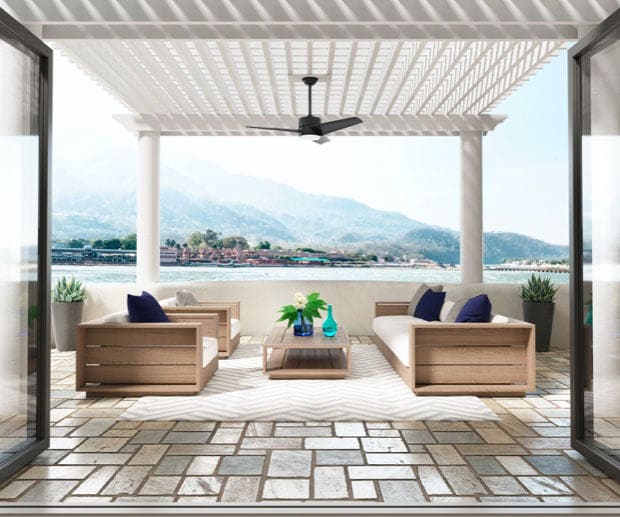
Outdoors
When choosing a ceiling fan for an outdoor space, pick a model with the appropriate Underwriters Laboratories (UL) and Electrical Testing Laboratories (ETL) rating. Otherwise, technical difficulties with the fan can arise. For example, if the fan isn't rated for the proper type of outdoor use and it's exposed to humidity or rain, pieces of the fan could rust and impact operation.
UL and ETL ratings can be broken down into two general categories: damp rated and wet rated. Use the following information to help you determine which outdoor ceiling fan may best suit your outdoor space.
Shop Outdoor FansDamp-rated fans
Damp-rated fans are designed for use in covered outdoor spaces, like covered patios or porches, or inside places like bathrooms and laundry rooms that aren't directly exposed to water but may come in contact with humidity. These fans withstand exposure to moisture and all hardware is constructed with rust-resistant stainless steel.
Wet-rated fans
Wet-rated fans are designed for use in outdoor spaces that may be exposed to elements like heavy snow or rain. Ideal for gazebos and pergolas, our wet-rated fans are engineered to withstand direct contact with water and moisture. These fans are built with moisture-resistant motors and all-weather blades for long-lasting and safe performance.

WeatherMax® fans
Hunter WeatherMax fans are built for the outdoors with features and technologies that go beyond the average wet-rated models. WeatherMax designs are corrosion- and salt air-resistant, perfect for beach properties or homes that get a lot of salt from snow trucks, while also featuring our SureSpeed® Guarantee for high-airflow-velocity performance.
Step 2.
What size ceiling fan do you need?
For maximum efficiency, choose an appropriate ceiling fan size for each room. Installing a fan that's too small for the space won't circulate air effectively to make the room feel cool. Alternatively, if you install a fan that's too large for the space, it could overpower the room, even on a lower setting. Use our ceiling fan size guide to determine what size ceiling fan you need for your room.
How to choose a ceiling fan size
SHOP BY FAN SIZE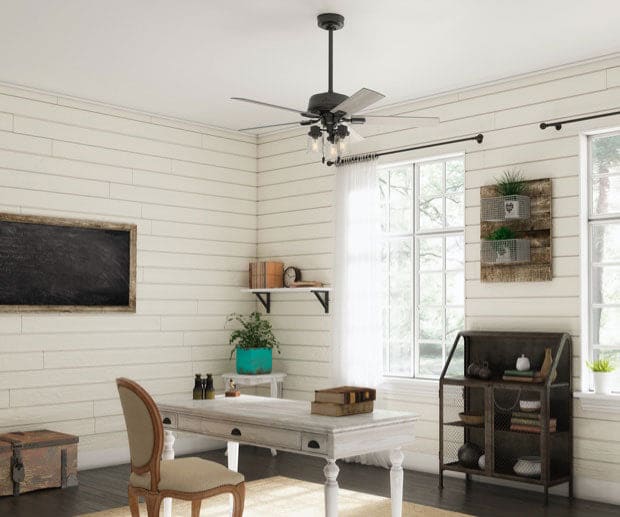
Fan diameter for room size
The amount of air circulated by a ceiling fan is determined by its diameter. Larger rooms require fans with larger diameters, while smaller spaces require fans with smaller diameters:
Small rooms
100 square feet or less work best with a small ceiling fans that range from 30 inches to 48 inches. Small diameter fan sizes are ideal for home offices and laundry rooms.
Large rooms
400 square feet or less work best with medium ceiling fans that range from 48 inches to 54 inches. Medium diameter fan sizes are ideal of living rooms, bedrooms, and kitchens.
Great rooms
Over 400 square feet work well with large ceiling fans 56 inches or larger. Large diameter ceiling fans are ideal for open-concept living areas or lofts with ample space.
Ceiling fan size guide
Want to learn what size ceiling fan to pick for rooms of various dimensions? While not all rooms are perfectly rectangular, this ceiling fan size guide can help you choose the right size fan for your room. It also shows you the types of rooms that generally fall within these dimensions.
| FAN SIZE | ROOM SIZE | ROOM TYPE |
|---|---|---|
| Less than 29" | Less than 5x10 |
Hallway
Laundry Room
Walk-In Closet
|
| 39" | Up to 8x10 |
Breakfast Nook
Large Bathroom
|
| 42" | Up to 10x10 |
Bedroom
Office
Kitchen
|
| 52" | Up to 10x20 |
Master Bedroom
Dining Room
Patio Area
|
| Greater than 56" | Up to 20x20 |
Living Room
Great Room
|
Step 3.
What ceiling fan style do you want?
Selecting the right ceiling fan style for your space is just as important as getting the ceiling fan size you need. Shop by ceiling fan style to find an option that will integrate with your existing design and use the following information to learn more about our style options.
How to choose a ceiling fan style

Design style
When choosing a ceiling fan style, use your existing furnishings and finishes as inspiration, or explore our ceiling fan options and build the rest of your decor around your choice. We offer reversible blade finishes that allow you to change the style of your fan throughout the year to keep your look fresh.
SHOP BY FAN STYLE
Modern
With their sleek designs, clean lines, and warm, neutral colors, modern ceiling fans are simple and understated in appearance. Modern fans vary in form from Scandinavian to mid-century designs.
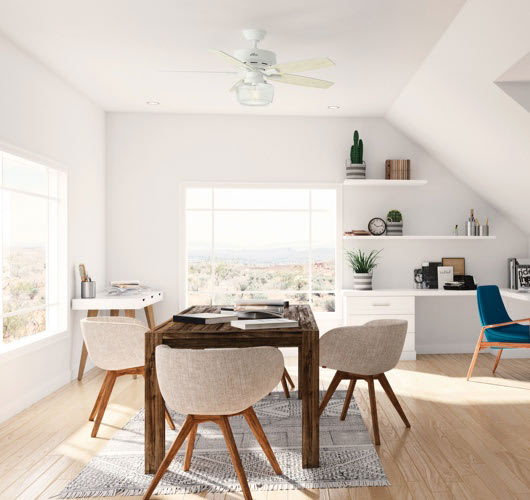
Traditional
These refined fans typically feature intricate details and thoughtful designs that add richness and warmth to a space. Our traditional ceiling fans blend classic style and innovative features.
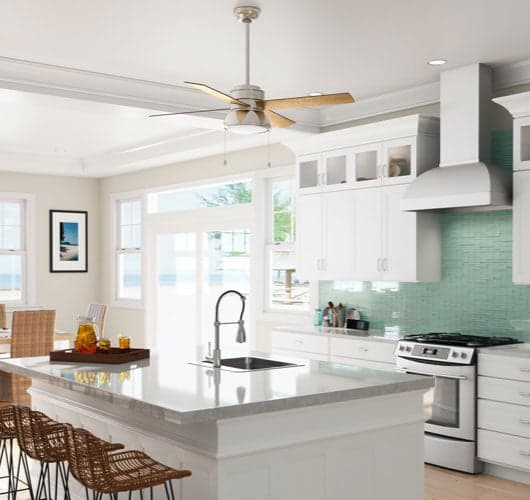
Rustic
An ideal addition to countryside-inspired designs, rustic ceiling fans create a natural feel. Cast-iron inspired housings and weathered blades bring cabin-like charm into the home and outdoor living spaces.
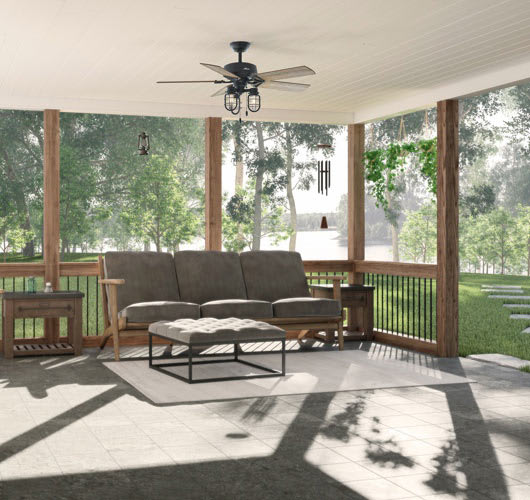
Industrial
Industrial style ceiling fans bring urban-inspired spaces to life drawing inspiration from modern machinery and unique features like propeller-style blades or smooth wood finishes.
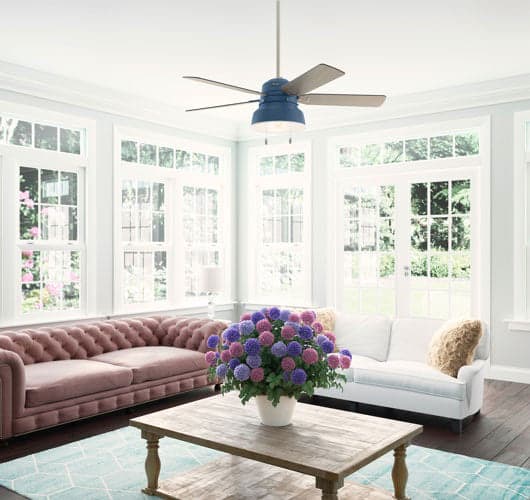
Farmhouse
Popular farmhouse ceiling fans create a warm and cozy ambiance that combines the comfort of rural living with the benefits of updated modern design for a style that stands the test of time.
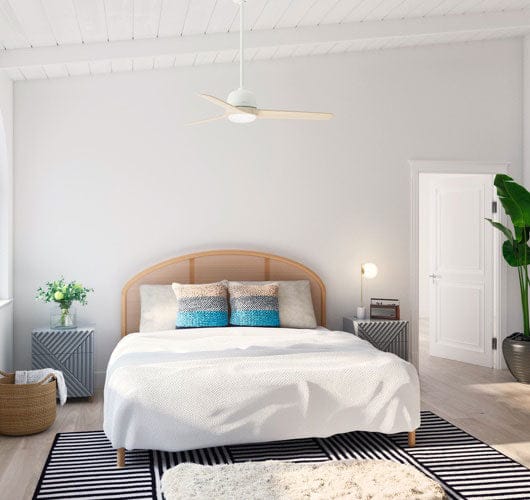
Contemporary
Contemporary ceiling fans are for those looking for a fixture that makes a statement as soon as you walk into the room. These fans push the boundaries of ceiling fan design and look like a work of art.
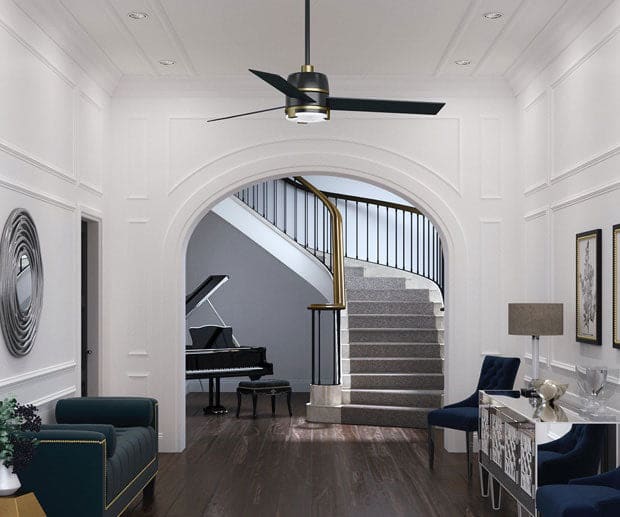
Blade and housing finishes
Ceiling fan colors and housing finishes set the tone of your space. For example, white ceiling fans complement most ceilings and instill a classic finishing touch in any room. Black ceiling fans make a bold statement, bringing an edgy and sophisticated look to spaces. Brass finishes and brushed nickel complement other hardware in your room. Finishing touches like ceiling fan glass shades and fan caps and finials also help refine the look of a fan and tie the overall design scheme together.
Step 4.
Lights or no lights?
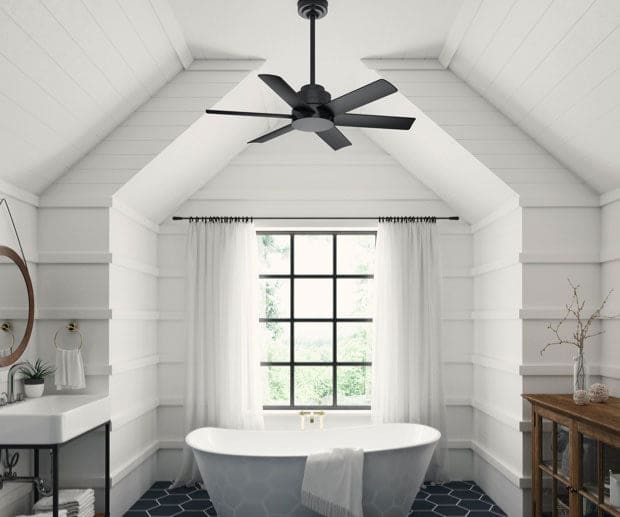
Fans without lights
If you plan to install your new fan in a room with good natural lighting or ample light from other sources, a ceiling fan without lights is a good option.
If you decide that you need more lighting in the future, many ceiling fan models can be easily modified after installation with the appropriate light kit.
SHOP FANS WITHOUT LIGHTS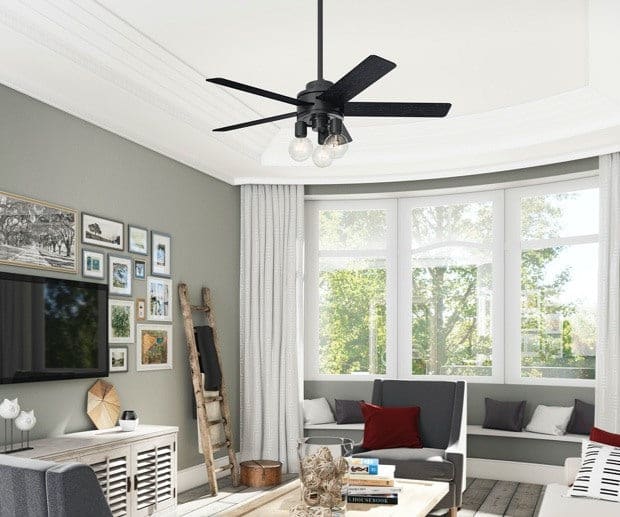
Fans with lights
For spaces with limited natural lighting, purchasing a ceiling fan with lights is a great option to consider. Ceiling fans with light kits can be supplemented with other fixtures to provide sufficient illumination in darker spaces.
When looking for ceiling fans with lights, check for integrated light dimming features. Ceiling fans with dimmable lights allow you to set the mood in your space. Our wall controls and handheld remotes make the process of adjusting your lighting easy, too.
SHOP FANS WITH LIGHTSToday's fans offer a wide array of lighting sources, including several energy-efficient options. Here's a breakdown of some of the most common types of lighting bulbs to consider:
LED
With an average life span of 50,000 hours, LED bulbs are the most energy-efficient option on the market. There are also a variety of LED bulbs found in ceiling fans today: more traditional bulbs, Edison bulbs with glowing filaments, and integrated LED discs that are designed to never need changing.
Fluorescent
These light bulbs have an average life span of 10,000 hours and use less energy than incandescent bulbs.
Halogen
With an average life span of 1,500 hours, halogen bulbs emit a warm light and use around 15-percent less energy than incandescent bulbs.
The number of bulbs a ceiling fan features influences the lighting ambiance of the space. For example, ceiling fans with single bowl light kits are ideal for larger spaces that require medium-level ambient lighting such as bedrooms, offices, kitchens, and living rooms.
For spaces where no other lighting is provided, fans with multi-arm lighting are a great option. These ceiling fans often feature three to four bulbs depending on their design. Their multiple bulbs spread light across the space, brightening the entire room.
With so many different types of ceiling fan lighting options available, designing the ideal lighting scheme for your home can seem confusing, so it's helpful to consider the intent of your lighting, or how you plan to use it.
Task lighting provides smaller, more concentrated light that's meant to increase visibility for projects like reading, working, and cooking. Ambient lighting produces a soft glow that illuminates a space enough for you to see while maintaining a warm tone.
Functional, single-source lighting provides a space with overall illumination. In rooms where lighting is limited, a ceiling fan that provides the main source of functional lighting is fundamental to a lighting scheme. In spaces where your primary goal is to accentuate decorative elements, a ceiling fan with an integrated downlight kit creates a clean and sophisticated look that won't overpower the other lighting in the room.
Step 5.
Which mount-type works best for your space?
Ceiling fan mounting and downrod options
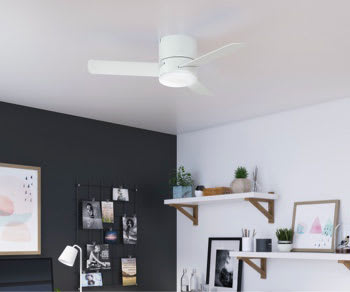
Flush-Mount / Low-Profile
Intended for rooms with ceiling heights around eight feet high, flush-mount applications are ideal. These low-profile ceiling fans are designed to install flush with the ceiling so the blades hang at a safe distance overhead.

Standard
Ceiling fans with a standard mount are designed for rooms where the ceiling height is around nine feet. The use of a ceiling fan downrod during installation ensures the appropriate hanging height of eight to nine feet from the floor.
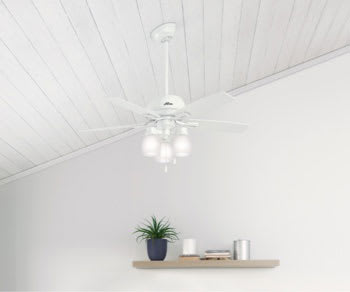
High and Vaulted Ceilings
When the ceiling height is greater than 10 feet, fans may need to be mounted without the use of an extended downrod. For sloped or vaulted ceilings exceeding 34 degrees, a sloped ceiling adapter kit must be used to ensure proper ceiling fan installation. This type of adapter replaces the ceiling fan canopy that comes with your fan.
Downrod guide
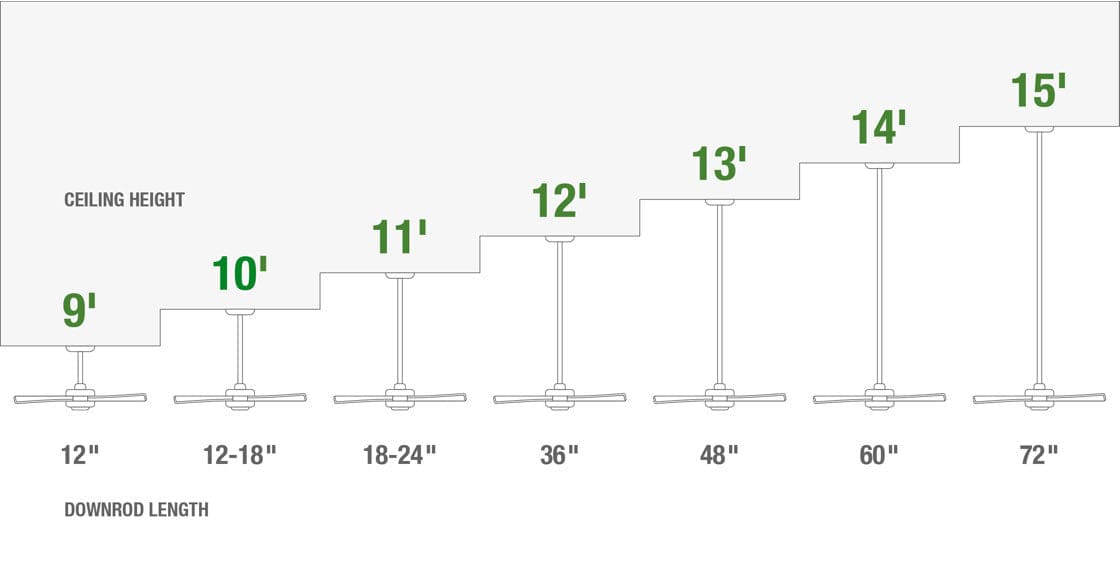
Step 6.
How do you want to control your fan?
Control your fan based on your preferences by choosing a control system that's convenient and works best for you. Simple ceiling fan controls rely on a wall switch that lets you turn the fan on and off and adjust its speed with a pull chain switch. Hunter's more advanced ceiling fan control systems allow you to control the fan's settings from a wall control or handheld remote.
Ceiling fan remote and controls
SHOP FANS WITH REMOTES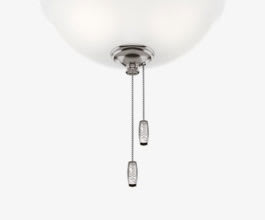
Pull chains
For rooms with lower ceilings where you're able to reach a pull chain, a ceiling fan with a pull chain is a great option. Pull chains also work well for outdoor closed spaces so you have the option of adjusting the speed without needing a remote.
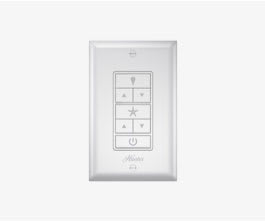
Wall control
Control your fan's direction and speed and easily dim the lights with the push of a button using a Hunter wall control. This type of control is mounted inside the wall light switch, which makes it simple to always remember where your ceiling fan control is located.
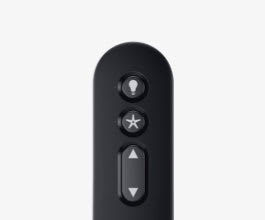
Remote control
A handheld remote offers increased convenience and comfort. Hunter ceiling fans with remotes let you dim the lights and adjust the fan's direction and speed with one easy-to-use device from wherever you are in the room. Simply keep the remote next to you on the coffee table or nightstand or use the included cradle to hang on your wall.
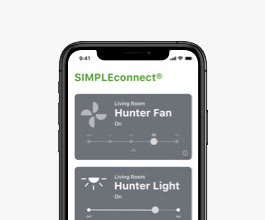
Smart home control
Hunter's SIMPLEconnect© Collection of Wi-Fi-enabled ceiling fans let you adjust your fan's settings using your smart device with our SIMPLEconnect app or via the included handheld remote. Use our ceiling fan smart home technology and your favorite home automation system to conveniently operate your fan.
Step 7.
What airflow/efficiency do you need?
When factoring how to choose a ceiling fan for your space, start by learning how energy-efficient fans can help your energy costs. Energy-efficient ceiling fans can help keep your space cooler in the summer and warmer during cold winter months.
Since a ceiling fan can help make a room feel six to eight degrees cooler in the summer, your air conditioner won't have to work as hard to cool your home. In the winter, by running your fan in a clockwise position on low speed, warm air will be pushed down and recirculated without creating a cooling effect.

Airflow you can feel
With optimized motors and precision blades, Hunter SureSpeed fans produce powerful air velocity while remaining whisper-quiet and wobble-free. The contoured, aerodynamic design of the blades on a SureSpeed fan produces a more uniform flow of air to effectively cool you. This means more of the high-speed cooling airflow can be felt throughout your space.
Learn about SureSpeed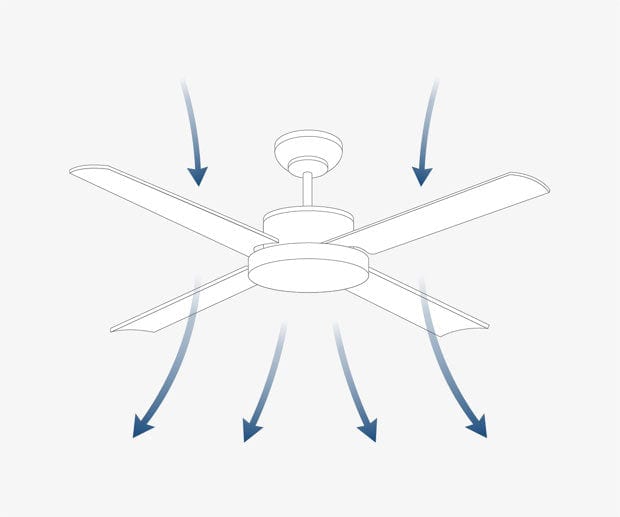
CFM
CFM stands for Cubic Feet per Minute and refers to the measurement of how much air is moved by a ceiling fan. More energy-efficient ceiling fans produce higher airflow while consuming less energy than standard fans. Hunter fans typically have higher CFM ratings than other models because we pitch our blades at the maximum possible angles and custom-engineer our motors.
Step 8.
What's your budget?
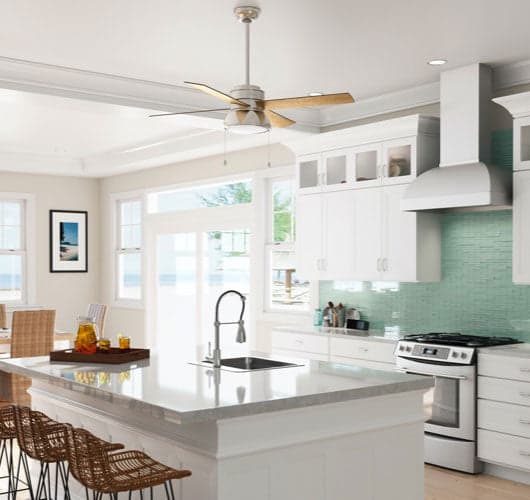
Fans for every space and budget
Hunter designs ceiling fans for every space and budget. Shop our fans by price to find a fit that's perfect for your needs and budget, or explore a variety of stunning luxury designs in our Casablanca line of ceiling fans.
The innovative designs and pioneering technology of Hunter bring new life into any space. Committed to excellence, we conduct twice the amount of industry-standard testing on each ceiling fan to ensure best-in-class performance. The above guide will help you navigate how to choose a ceiling fan that perfectly suits your preferences.
SHOP FANS NOW



